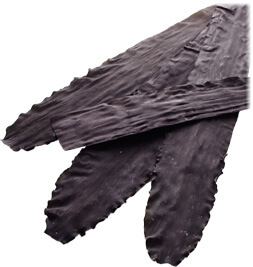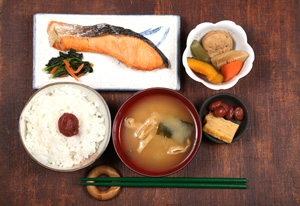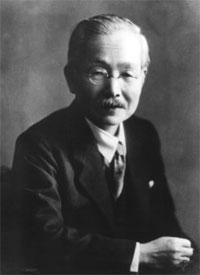

On December 4th, 2013, "Washoku: Traditional dietary cultures of the Japanese" was approved to be enlisted on UNESCO's intangible cultural heritage. This decision of enlisting Washoku to intangible cultural heritage is expected to re-acknowledge values of Washoku to the world.
There are many characteristics of Washoku but the biggest characteristic is that "utilizing variety of indigenous ingredients that are fresh and brings out ingredient's characteristics with Dashi." As just described, "Dashi" is closely tied with Washoku and existence of Dashi helped tremendously to enlistment of intangible cultural heritage.
On this page, we will describe Washoku's greatest palate, secret of "Dashi"

Do you know what the "Dashi" is?
"Dashi" is the soup broth that plays a vital role as a pillar of Washoku, and is made from seaweed called Kombu seaweed.
There are many cuisines that utilize soup broth such as French buillon and Chinese tang. However, those soup broths are made from simmering variety of meats, vegetables and seafoods, results in a bold ingredients taste.
On the other hand, Washoku’s "Dashi" is made from Kombu seaweeds with short amount of time. Moreover, "Dashi" has a unique trait that Kombu seaweed's elegant flavor has and flatters ingredients flavor, which no other soup broth have. That's what makes Washoku stand out and secret of "Dashi".
In other word, Kombu seaweed has been a driving force of Washoku.

Japan is surrounded by variety of distinct environments.
One of them is the ocean surrounding all around Japan. Many different current from north to the south meet in Japan, resulting in a rich fishing grounds and nurturing rich seafood culture such as Sushi.
With the land extending from north to south, each region has different climate and locality. This helped formation of different regions and cultures using unique local ingredients. In many regions, simmered dishes using local ingredients has been passed on.
Kombu seaweed was often used to enhance the flavor of ingredients such as when cooking rice for sushi,Kombu seaweed has been always cooked together. Dashi using Kombu seaweed were also indispensable for a making simmered dishes.
Utilizing Kombu seaweed makes it possible for Washoku to increase the flavor of ingredients.

In Washoku, Kombu seaweed was used to increase the ingredients natural flavor as described previously. Due to this unique trait, people can get satisfaction without using much animal fat, and said to be the secret of low obesity rate in Japan.
Moreover, Washoku is generally composed with “ICHIJU-SANSAI", which literally means composed with a soup dish, a main dish, and two side dishes. From nutritional science standpoint, this composition is said to be the ideal menu with balanced nutrition. The soup is important factor that makes up this ICHIJU-SANSAI and healthy menu can not be done without the existence of soup. To make Japanese soup, Dashi made from Kombu seaweed is essential and it's not too much to say that the soup without Dashi is not soup. From all this above, you can tell that the Kombu seaweed is indispensable to Washoku!

Washoku is closely tied with seasonal annual events and occasions.
The best example to come up is the New Year. Japanese people traditionally eat cuisine called Osechi during new years. Osechi is the cuisine composed of various dishes into the bento box called "Jubako", a multitiered boxes, and each dish contains a auspicious meaning and wish for coming year using puns. It is not unusual for other countries and cultures to cook special dishes to celebrate new years, but no other dishes put emphasis on meaning to every ingredient they use like Osechi.
Typical Osechi include food such as Nishime (simmered dish) and kombu roll, a Kombu seaweed into a roll and simmered. Each Nishime ingredients have auspicious meaning, for instance, taro potato used for nishime is used for hope for fertility due to its fertility during harvest. Kombu roll using Kombu seaweed represents hope for joyful year as Japanese word for joy, "yoro-kobu" as kombu rhymes.
These recipes all uses Kombu seaweed to cook. Nishime uses Dashi during simmering, and kombu roll isKombu seaweed itself as the name describe. In other word, Japanese celebrate New Year with Kombu seaweed.
 Dr. Kikunae Ikeda
Dr. Kikunae Ikeda
We've emphasized that we can hardly discuss Washoku without taking Kombu seaweed into account, but does anyone know what makes Kombu seaweed taste so delectable? Sweetness? Sourness? Nope, "Umami" is what makes Kombu seaweed special. Umami is the savory flavor during eating Kombu seaweed that doesn't belong to any of sweetness, sourness, bitterness, saltiness and it derived from Japanese word for deliciousness.
In western society, four flavors that mentioned above was long recognized as the basic flavor of food, but there were one flavor component that could not be described with any of those four basic flavors. (For your information, spiciness does not belong to basic flavor due to spiciness is not the flavor but the sensory to the tongue.) That unexplainable taste is now known as UMAMI and discovered by Dr. Kikunae Ikeda of Tokyo Imperial University' (current Tokyo University).
Dr. Ikeda is said to have had interest in Dashi from early adolescence. "What makes Dashi so special?" He wondered and conducted experiment to find out Umami causing substance, glutamic acid, on 1908. Glutamic acid did not belong to any of pre-existing basic flavor, thus naming it "Umami". That's right, Umami was found using Kombu seaweed!
This fifth flavor, Umami was long disscussed in western world. However, after nearly 100 years later, studies conducted on 2000, revealed that glutamic acid receptor were found in taste bud, and Umami is accepted as one of the basic flavor.